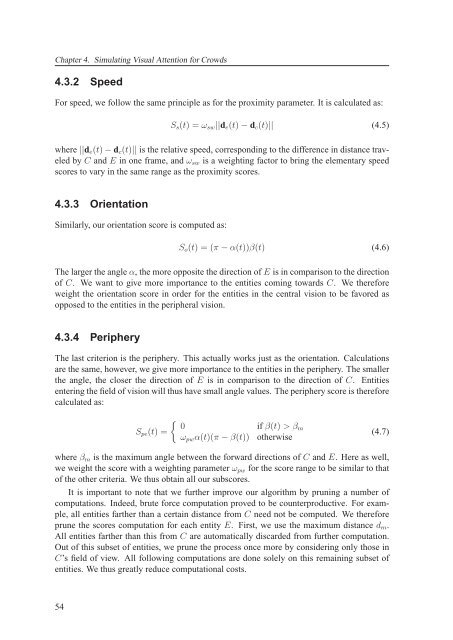Texte intégral / Full text (pdf, 20 MiB) - Infoscience - EPFL
Texte intégral / Full text (pdf, 20 MiB) - Infoscience - EPFL
Texte intégral / Full text (pdf, 20 MiB) - Infoscience - EPFL
You also want an ePaper? Increase the reach of your titles
YUMPU automatically turns print PDFs into web optimized ePapers that Google loves.
Chapter 4. Simulating Visual Attention for Crowds<br />
4.3.2 Speed<br />
For speed, we follow the same principle as for the proximity parameter. It is calculated as:<br />
Ss(t) =ωsw||de(t) − dc(t)|| (4.5)<br />
where ||de(t) − dc(t)|| is the relative speed, corresponding to the difference in distance traveled<br />
by C and E in one frame, and ωsw is a weighting factor to bring the elementary speed<br />
scores to vary in the same range as the proximity scores.<br />
4.3.3 Orientation<br />
Similarly, our orientation score is computed as:<br />
So(t) =(π − α(t))β(t) (4.6)<br />
The larger the angle α, the more opposite the direction of E is in comparison to the direction<br />
of C. We want to give more importance to the entities coming towards C. We therefore<br />
weight the orientation score in order for the entities in the central vision to be favored as<br />
opposed to the entities in the peripheral vision.<br />
4.3.4 Periphery<br />
The last criterion is the periphery. This actually works just as the orientation. Calculations<br />
are the same, however, we give more importance to the entities in the periphery. The smaller<br />
the angle, the closer the direction of E is in comparison to the direction of C. Entities<br />
entering the field of vision will thus have small angle values. The periphery score is therefore<br />
calculated as:<br />
Spe(t) =<br />
0 if β(t) >βm<br />
ωpwα(t)(π − β(t)) otherwise<br />
(4.7)<br />
where βm is the maximum angle between the forward directions of C and E. Here as well,<br />
we weight the score with a weighting parameter ωpw for the score range to be similar to that<br />
of the other criteria. We thus obtain all our subscores.<br />
It is important to note that we further improve our algorithm by pruning a number of<br />
computations. Indeed, brute force computation proved to be counterproductive. For example,<br />
all entities farther than a certain distance from C need not be computed. We therefore<br />
prune the scores computation for each entity E. First, we use the maximum distance dm.<br />
All entities farther than this from C are automatically discarded from further computation.<br />
Out of this subset of entities, we prune the process once more by considering only those in<br />
C’s field of view. All following computations are done solely on this remaining subset of<br />
entities. We thus greatly reduce computational costs.<br />
54

















